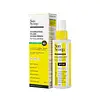What's inside
What's inside
 Key Ingredients
Key Ingredients

 Benefits
Benefits

 Concerns
Concerns

 Ingredients Side-by-side
Ingredients Side-by-side

Water
Skin ConditioningCaprylyl Methicone
Skin ConditioningDibutyl Adipate
EmollientNiacinamide
SmoothingPropanediol
SolventEthylhexyl Methoxycinnamate
UV AbsorberPEG-12 Dimethicone/PPG-20 Crosspolymer
Butyl Methoxydibenzoylmethane
UV AbsorberButylene Glycol
HumectantBis-Ethylhexyloxyphenol Methoxyphenyl Triazine
Skin ConditioningSargassum Fluitans / Natans Extract
Polysorbate 20
EmulsifyingPhenoxyethanol
PreservativeAllantoin
Skin ConditioningMenthone Glycerin Acetal
RefreshingDiethylhexyl Butamido Triazone
UV AbsorberPentylene Glycol
Skin ConditioningXanthan Gum
EmulsifyingPhospholipids
Skin ConditioningAcrylates/C10-30 Alkyl Acrylate Crosspolymer
Emulsion StabilisingAloe Barbadensis Leaf Extract
EmollientCentella Asiatica Extract
CleansingSodium Polyacrylate
AbsorbentEthylhexylglycerin
Skin ConditioningHydroxyethyl Acrylate/Sodium Acryloyldimethyl Taurate Copolymer
Emulsion StabilisingTocopheryl Acetate
AntioxidantVp/Acrylates/Lauryl Methacrylate Copolymer
Water, Caprylyl Methicone, Dibutyl Adipate, Niacinamide, Propanediol, Ethylhexyl Methoxycinnamate, PEG-12 Dimethicone/PPG-20 Crosspolymer, Butyl Methoxydibenzoylmethane, Butylene Glycol, Bis-Ethylhexyloxyphenol Methoxyphenyl Triazine, Sargassum Fluitans / Natans Extract, Polysorbate 20, Phenoxyethanol, Allantoin, Menthone Glycerin Acetal, Diethylhexyl Butamido Triazone, Pentylene Glycol, Xanthan Gum, Phospholipids, Acrylates/C10-30 Alkyl Acrylate Crosspolymer, Aloe Barbadensis Leaf Extract, Centella Asiatica Extract, Sodium Polyacrylate, Ethylhexylglycerin, Hydroxyethyl Acrylate/Sodium Acryloyldimethyl Taurate Copolymer, Tocopheryl Acetate, Vp/Acrylates/Lauryl Methacrylate Copolymer
Water
Skin ConditioningEthylhexyl Salicylate
UV AbsorberButyl Methoxydibenzoylmethane
UV AbsorberOctocrylene
UV AbsorberGlycerin
HumectantBetaine
HumectantCoco-Caprylate
EmollientZinc Oxide
Cosmetic ColorantStearic Acid
CleansingPhenoxyethanol
PreservativeCetyl Alcohol
EmollientGlyceryl Stearate
EmollientAmmonium Acryloyldimethyltaurate/Vp Copolymer
Propylene Glycol
HumectantMenthol
MaskingMethyl Diisopropyl Propionamide
MaskingEthyl Menthane Carboxamide
TonicMenthyl Lactate
MaskingHydroxypropylcellulose
EmulsifyingTocopheryl Acetate
AntioxidantAloe Barbadensis Leaf Extract
EmollientChamomilla Recutita Flower Extract
MaskingAvena Sativa Kernel Extract
AbrasiveCaesalpinia Spinosa Fruit Extract
Skin ProtectingHelianthus Annuus Sprout Extract
Skin ConditioningCitrus Aurantium Dulcis Peel Oil
MaskingRosmarinus Officinalis Leaf Oil
MaskingSodium Benzoate
MaskingDisodium EDTA
Sodium Hydroxide
BufferingWater, Ethylhexyl Salicylate, Butyl Methoxydibenzoylmethane, Octocrylene, Glycerin, Betaine, Coco-Caprylate, Zinc Oxide, Stearic Acid, Phenoxyethanol, Cetyl Alcohol, Glyceryl Stearate, Ammonium Acryloyldimethyltaurate/Vp Copolymer, Propylene Glycol, Menthol, Methyl Diisopropyl Propionamide, Ethyl Menthane Carboxamide, Menthyl Lactate, Hydroxypropylcellulose, Tocopheryl Acetate, Aloe Barbadensis Leaf Extract, Chamomilla Recutita Flower Extract, Avena Sativa Kernel Extract, Caesalpinia Spinosa Fruit Extract, Helianthus Annuus Sprout Extract, Citrus Aurantium Dulcis Peel Oil, Rosmarinus Officinalis Leaf Oil, Sodium Benzoate, Disodium EDTA, Sodium Hydroxide
Ingredients Explained
These ingredients are found in both products.
Ingredients higher up in an ingredient list are typically present in a larger amount.
Aloe Barbadensis Leaf Extract is an extract of the leaves of the aloe, Aloe barbadensis, Liliaceae.
Aloe is one of the most well-known natural soothing ingredients, and for good reason. It’s full of water and has a cooling, calming effect on the skin, especially when it’s sunburned, itchy, or irritated. Aloe also helps your skin stay hydrated and smooth by mimicking what healthy skin naturally produces. On top of that, it contains vitamins and nutrients that support skin recovery.
It doesn’t protect you from the sun, but it can help your skin bounce back after too much time in it.
Let’s get into the details:
Aloe contains antioxidant Vitamins A, C, and E, which help fight off free radicals (unstable molecules from things like pollution that can damage your skin).
It’s also rich in polysaccharides, which are natural sugars that help hydrate the skin by acting like the skin’s own moisturizing agents. These, along with other sugars like monosaccharides, help form a protective barrier that locks in moisture.
Aloe works as both a humectant and an emollient. That means it draws water into the skin (humectant) and helps trap it there (emollient), making it an effective natural moisturizer.
You’ll also find a mix of other skin-supporting ingredients in aloe, including folic acid, choline, calcium, amino acids, fatty acids, and even Vitamin B12.
Out of the 420+ species of aloe, Aloe barbadensis is the most widely used in skincare products thanks to its gentle yet effective properties.
There are over 420 species of aloe but Aloe Barbadensis is the most commonly used for topical products.
Learn more about Aloe Barbadensis Leaf ExtractAlso known as Avobenzone, this ingredient is a chemical sunscreen filter that provides protection in the UV-A range.
Avobenzone is globally approved and is the most commonly used UV-A filter in the world.
Studies have found that avobenzone becomes ineffective when exposed to UV light (it is not photostable; meaning that it breaks down in sunlight). Because of this, formulations that include avobenzone will usually contain stabilizers such as octocrylene.
However, some modern formulations (looking at you, EU!) are able to stabilize avobenzone by coating the molecules.
Avobenzone does not protect against the UV-B range, so it's important to check that the sunscreen you're using contains other UV filters that do!
The highest concentration of avobenzone permitted is 3% in the US, and 5% in the EU.
Learn more about Butyl MethoxydibenzoylmethanePhenoxyethanol is a preservative that has germicide, antimicrobial, and aromatic properties. Studies show that phenoxyethanol can prevent microbial growth. By itself, it has a scent that is similar to that of a rose.
It's often used in formulations along with Caprylyl Glycol to preserve the shelf life of products.
Tocopheryl Acetate is AKA Vitamin E. It is an antioxidant and protects your skin from free radicals. Free radicals damage the skin by breaking down collagen.
One study found using Tocopheryl Acetate with Vitamin C decreased the number of sunburned cells.
Tocopheryl Acetate is commonly found in both skincare and dietary supplements.
Learn more about Tocopheryl AcetateWater. It's the most common cosmetic ingredient of all. You'll usually see it at the top of ingredient lists, meaning that it makes up the largest part of the product.
So why is it so popular? Water most often acts as a solvent - this means that it helps dissolve other ingredients into the formulation.
You'll also recognize water as that liquid we all need to stay alive. If you see this, drink a glass of water. Stay hydrated!
Learn more about Water